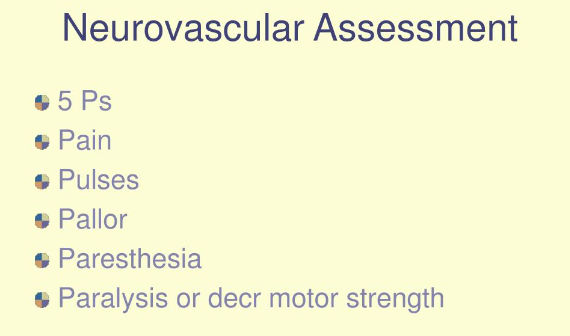Pain, Pallor, Pulse… and More! The 5 P’s of Neurovascular Assessment
Definition of Neurovascular Assessment
Neurovascular assessment involves the systematic evaluation of blood circulation and neurological function in various parts of the body. This assessment is vital for detecting issues early on and preventing complications.
Importance of Neurovascular Assessment in Healthcare
Understanding the neurovascular status of a patient is fundamental for healthcare professionals. It provides valuable insights into the patient’s overall health, aids in diagnosis, and guides appropriate interventions.

The 5 p’s of neurovascular assessment
Pain
1. Assessing the Patient’s Pain Perception
Pain perception varies among individuals. Healthcare providers must assess and understand the patient’s experience of pain to gauge the severity of potential neurovascular issues.
2. Recognizing Pain Patterns
Different conditions manifest with distinct pain patterns. Recognizing these patterns can help healthcare professionals pinpoint the potential source of neurovascular complications.
Pulse
1. Evaluating Peripheral Pulses
Assessing peripheral pulses provides critical information about blood flow. Irregular or weak pulses may indicate underlying vascular problems, prompting further investigation.
2. Understanding Pulse Discrepancies
Discrepancies between pulses in different extremities can be indicative of vascular abnormalities. Healthcare providers must carefully compare and analyze pulse findings.
Pallor
1. Observing Skin Color Changes
Changes in skin color, particularly pallor, may signify compromised blood flow. Understanding the correlation between skin color and vascular health is essential for accurate assessments.
2. Correlation with Blood Flow
Pallor may indicate reduced blood flow, raising concerns about potential arterial or venous issues. Healthcare professionals need to consider this aspect while conducting neurovascular assessments.
Paresthesia
1. Identifying Abnormal Sensations
Paresthesia involves abnormal sensations, such as tingling or numbness. Detecting these sensations can guide healthcare providers in identifying nerve dysfunction and potential vascular compression.
2. Nerve Dysfunction Signs
Certain neurovascular issues can lead to nerve dysfunction. Recognizing signs of paresthesia helps in early intervention to prevent further complications.
Paralysis
1. Detecting Motor Function Abnormalities
Assessing motor function is crucial in neurovascular assessment. Paralysis or weakness may indicate impaired blood supply to specific areas, warranting immediate attention.
2. Implications for Neurological Health
Understanding the implications of paralysis on neurological health is vital for developing effective treatment plans. Neurovascular assessment aids in determining the severity and potential causes of motor function abnormalities.
Importance in Different Patient Populations
Pediatric Patients
Neurovascular assessment is especially critical in pediatric patients, where early detection can prevent long-term complications. Providers must adapt assessment techniques for this population.
Geriatric Patients
Geriatric patients may experience age-related changes in neurovascular function. Regular assessments help in identifying and managing these changes, promoting overall well-being.
Patients with Chronic Illnesses
Individuals with chronic illnesses, such as diabetes or cardiovascular diseases, are at a higher risk of neurovascular complications. Tailoring assessments to address specific concerns in these populations is essential.
Neurovascular Assessment Techniques
Overview of Assessment Tools
Healthcare providers use various tools, including Doppler ultrasound and sensory testing, to perform neurovascular assessments. Familiarity with these tools is crucial for accurate evaluations.
Step-by-Step Guide for Healthcare Professionals
A step-by-step guide ensures consistency and thoroughness in neurovascular assessments. Healthcare professionals should follow a standardized approach to obtain reliable results.
Conclusion
In conclusion, the 5 p’s of neurovascular assessment—Pain, Pulse, Pallor, Paresthesia, and Paralysis—are integral components in evaluating the perfusion and function of nerves and blood vessels.
FAQs
What are the common signs of neurovascular issues?
Common signs include changes in pain perception, irregular pulses, skin color changes, abnormal sensations, and motor function abnormalities.
How often should neurovascular assessments be performed?
The frequency depends on the patient’s risk factors and medical history. However, regular assessments are recommended, especially in high-risk populations.
Can neurovascular assessment detect early signs of neurological disorders?
Yes, neurovascular assessments can detect early signs of neurological disorders, allowing for timely intervention and management.
